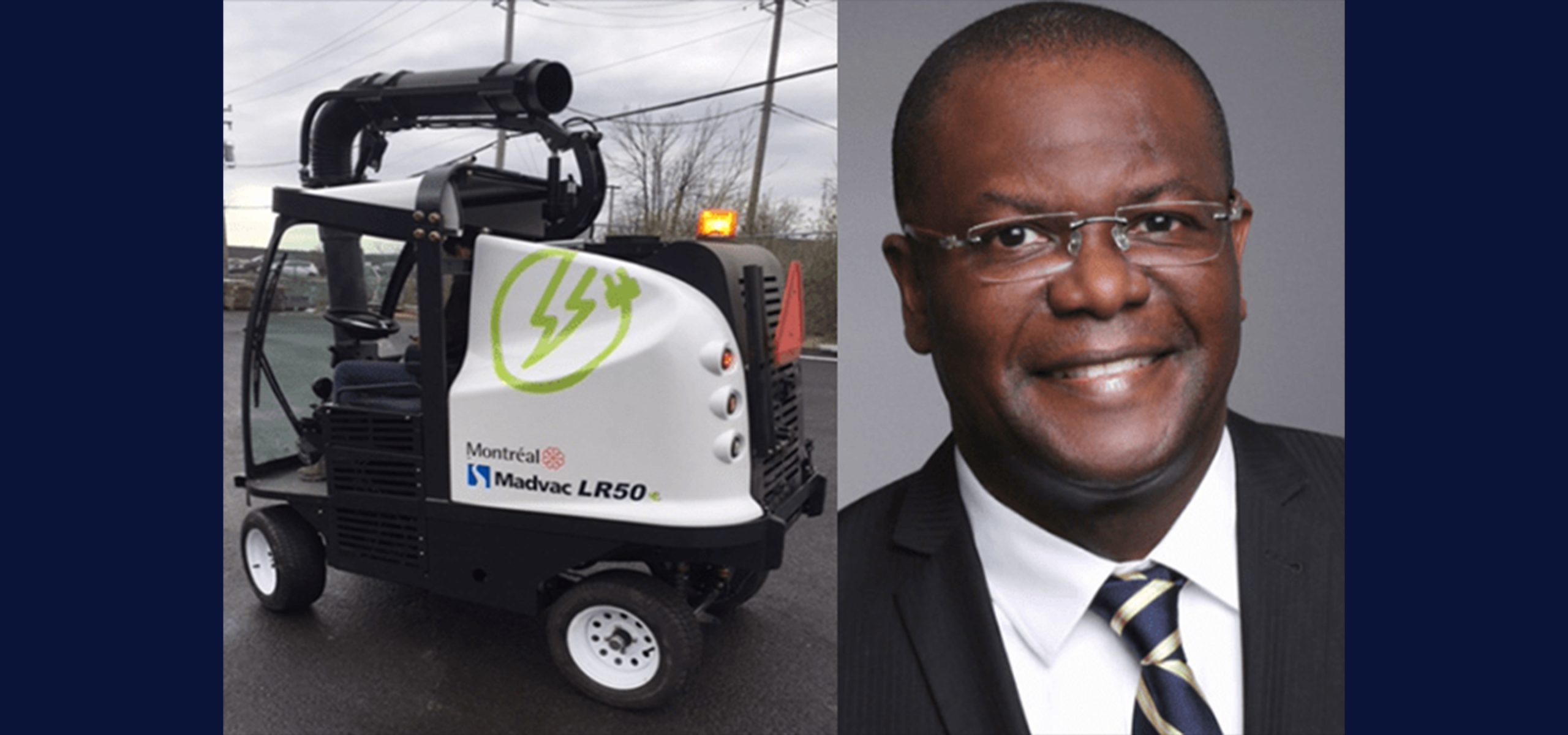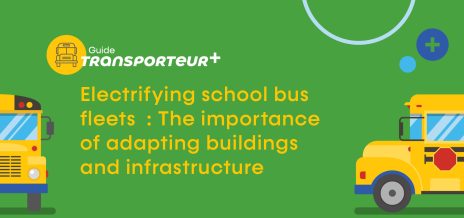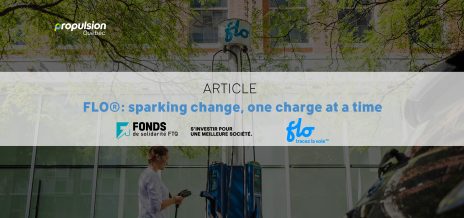Interview with Philippe Saint-Vil

The City of Montreal: A key player in energy transition
The City of Montreal made electromobility a priority in its Rolling Stock Green Policy 2016–2020, with plans to replace 250 end-of-life vehicles with fully electric vehicles. We spoke with Philippe Saint-Vil about this energy transition and how the city intends to position itself as a North American leader in transportation electrification.
Philippe Saint-Vil heads up planning and operations support at the City of Montreal’s Service du matériel roulant et des ateliers (rolling stock and workshops department), which is overseen by the institutional services division.
With 2020 around the corner, how close is the city to achieving its goal?
Since we adopted our last policy in 2016, 210 all-electric vehicles have been acquired, so we are 84% of the way to reaching our target. With 20 more vehicles per year in 2019 and 2020, the target will likely be met or exceeded by the end of 2020. Excluding SPVM vehicles (Service de police de la Ville de Montreal), a third of the city’s subcompact vehicles will eventually be replaced.
What are the issues surrounding energy conversion of the City of Montreal fleet?
Given the impact of climate change and the need for ecological transition, the issues are first and foremost environmental. The transportation sector alone accounts for 40% of greenhouse gas emissions, so energy conversion is a viable solution. There are also infrastructure issues, including the installation of charging stations in some boroughs that lease office space from real estate companies. Because the land does not belong to the city, certain considerations must be taken into account when charging stations are installed. There are technology challenges too, specifically with the arrival of fast charging stations in the City of Montreal. What’s more, a genuine electrification industry is developing in Quebec so there are economic and social issues as well.
What challenges did you encounter when integrating all-electric vehicles into your fleet?
The biggest challenge had to do with the range of the electric vehicles and city employees’ perceptions of it. For example, our usage data indicates that 95% of subcompact municipal vehicles traveled an average of 23 kilometers per day, with the exception of parking agents’ vehicles. At the time, electric vehicles had a range of 120 kilometers, so even in extreme cold (where the range is reduced by about 40% to 50%), it was unlikely that a fully electric vehicle would fail to meet our operational needs. But we had to set up pilot projects to overcome pushback we were getting from some customers and users. Change management has been central to our approach from the very beginning. I should point out that the electrification strategy has never been imposed on our various business units, to avoid compromising their operational needs. When a project was not successful at a given department or there were potential risks, we chose not to pursue it.
Tell me about the agreement between the City of Montreal and the City of New York regarding Montreal’s loan of three fully electric prototypes to New York. What’s the goal of the agreement and what are you hoping to get out of it?
The City of Montreal is a model for transportation electrification in North America. We are always sharing our experience and best practices with cities that, like us, are committed to energy transition. But we also want to go further, especially in our collaborative efforts, by lending fully electric prototypes to other North American cities. The economic and social benefits of energy transition shouldn’t be overlooked. Quebec is increasingly positioning itself as a key player. Loaning prototypes that are designed and developed in Quebec is an exceptional showcase opportunity for local businesses.
For example, Madvac, which is based in Longueuil, designed a fully electric vacuum litter collector, the first in North America. When we approached the City of New York, they showed immediate interest. We are currently carrying out the final tests and expect the prototypes to go into service in May. The idea is to position the two cities as leaders in transportation electrification and foster collaboration between them. The vehicles will share the same visual identity. If the City of New York is interested, it could help Madvac expand and create new jobs, which would have a significant economic impact in the Greater Montreal area.
Since climate issues are everyone’s responsibility, we want to encourage other cities to embrace electrification.
What other types of municipal vehicles besides subcompact automobiles could be targets for electromobility?
The City of Montreal’s Service du matériel roulant et des ateliers, which is responsible for fleet management at the city, is monitoring the situation closely. But we are also looking to encourage development of new products based on our needs. That’s why we sometimes reach out to suppliers, subcontractors, research centers, and academic institutions. Other than the litter collectors I already mentioned, we will soon have fully electric carts for parks, along with bicycles as part of a pilot project with the SPVM. We are also considering the possibility of acquiring tractors and snowmobiles for the City of Montreal’s Service des grands parcs, du Mont-Royal et des sports (department of large parks, Mount Royal, and sports). Five such projects are currently under review.
What is your take on this transportation electrification project? What are the prospects for the future?
As you can see, the results are very positive, which is promising for the coming years. With the Rolling Stock Green Policy 2016–2020 coming to an end, we will announce the main features of the new 2021–2025 policy in the coming months, but the final guidelines still have to be approved by our elected officials. We are keen to continue with the electrification of the City of Montreal’s municipal fleet. But we are also monitoring vehicles and equipment that can be powered by other types of energy. Stay tuned for further developments in that area.
Continue reading on this subject

The challenges of designing a 40-tonne, 100% electric mining vehicle for open-pit mines
Partnerships and implications The partners involved in the development of a 100% electric Quebec mining vehicle were all eager to be involved with the project from the outset, for a variety of reasons. NRC’s Eddy Zuppel explained their contribution: “Before starting the project, it was important to model and simulate the vehicle’s route in order […]
Read more
Energy efficiency: Financial support to put your ideas into action
Leading a company involves balancing several priorities at the same time. Energy efficiency? It’s an important issue—one of many! What if we gave you what you need to make energy efficiency a driving force behind your company’s performance and profitability? The good news is, Hydro-Québec offers financial assistance and guidance to help you balance performance and energy efficiency.
Read more
My Consumption Profile: data that lets you strategically manage your electricity use
Companies have a critical role to play in the energy transition. Knowing that energy efficiency factors big into profitability, your organization will benefit from strategically managing its electricity use. The key? Your data!
Read more
Electrifying school bus fleets : Grants available to support your project
In this series of articles, we demystify the key steps of converting your school bus fleet to electric power thanks to the Transporteur+ guide. This guide aims to provide easy and direct access to resources to clarify the steps, issues, conditions and facilitating measures for a successful transition to electrification.
Read more
Electrifying school bus fleets | Key step : Comissioning
In this series of articles, we demystify the key steps of converting your school bus fleet to electric power thanks to the Transporteur+ guide. This guide aims to provide easy and direct access to resources to clarify the steps, issues, conditions and facilitating measures for a successful transition to electrification.
Read more
FINANCING | $50 million from Finalta Capital in non-dilutive financing dedicated to the Electric and Smart Transportation sector
Fast growing, innovative companies from the electric and smart transportation (EST) sector in Québec take advantage of the $50 million in funding dedicated to the EST ecosystem by Finalta Capital, one of Canada’s largest funds specialized in non-dilutive tax credit and government grant financing, announced in March 2023 as part of the Impulsion conference, the International EST Summit organized by Propulsion Québec.
Read more
Demand response: Save money by using hydro at the right times
If you could lower your company's hydro bill while contributing to the collective effort to support Quebec’s energy transition, would you? Yes, most likely! How? By curbing power demand for buildings and equipment during peak demand events.
Read more
Electrifying school bus fleets : The importance of adapting buildings and infrastructure
In this series of articles, we demystify the key steps of converting your school bus fleet to electric power thanks to the Transporteur+ guide. This guide aims to provide easy and direct access to resources to clarify the steps, issues, conditions and facilitating measures for a successful transition to electrification.
Read more
Electrifying school bus fleets : Implementing the pilot project and phase-in
In this series of articles, we demystify the key steps of converting your school bus fleet to electric power thanks to the Transporteur+ guide. This guide aims to provide easy and direct access to resources to clarify the steps, issues, conditions and facilitating measures for a successful transition to electrification
Read more
Electrifying school bus fleets: The importance of choosing your suppliers
In this series of articles, we demystify the key steps of converting your school bus fleet to electric power thanks to the Transporteur+ guide. This guide aims to provide easy and direct access to resources to clarify the steps, issues, conditions and facilitating measures for a successful transition to electrification.
Read more
The key to a successful school bus fleet electrification project
In this series of articles, we demystify the key steps of converting your school bus fleet to electric power thanks to the Transporteur+ guide. This guide aims to provide easy and direct access to resources to clarify the steps, issues, conditions and facilitating measures for a successful transition to electrification.
Read more
FLO®: sparking change, one charge at a time
FLO became a leader in electric vehicle (EV) charging in North America by integrating the process from start to finish: manufacturing charging stations, developing software and managing its network. To stay ahead of the curve in a fast-moving, innovation-driven market, the company turned to the Fonds de solidarité FTQ to support its growth.
Read more




